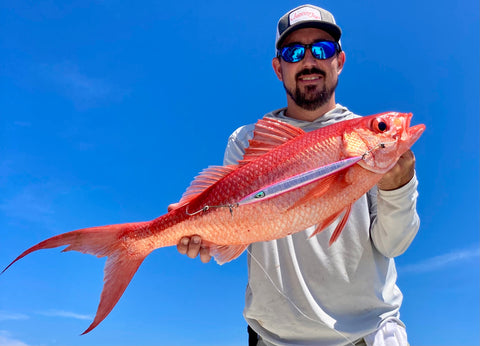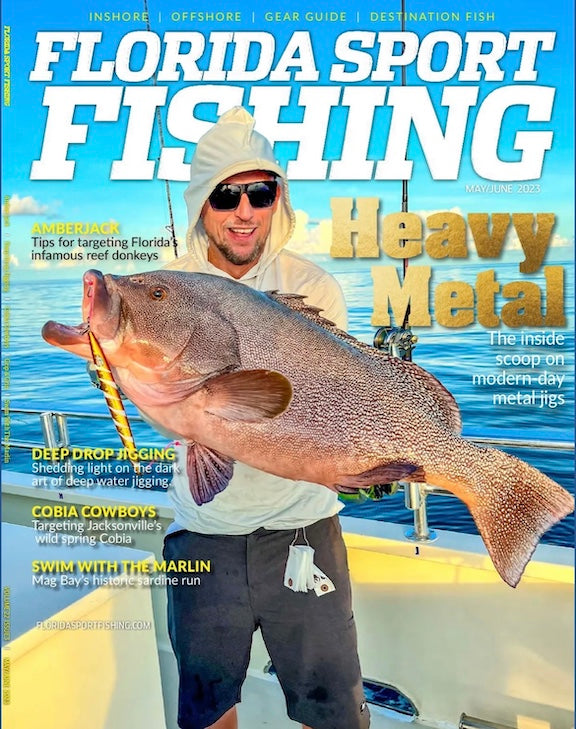Deep Dropping: Shedding Light on the Dark Art of Deep Water Jigging
By Johnny Steadham
I pull back the lever, releasing my reel into free spool. My 300-gram, wide-profile slow pitch jig starts to fall rapidly toward the bottom at first. The line is peeling off the spool and eventually begins to slow down. It keeps going and going for what seems like forever until eventually my 30-pound test PE braided line is down to the knot and I never felt bottom.
It was a long ride to get out to this deep drop spot. I have no backup plan for fishing in these depths and now I need to manually crank 500 yards of line back onto my reel with no reward. This was my first attempt trying to deep drop a slow pitch jig. Honestly, I felt a bit defeated, but even more curious and determined to figure this out.
There just wasn’t much information available on slow pitch jigging when my crew and I started, let alone deep drop jigging. This was the final frontier for us, and it had only been done by a handful of anglers in the U.S. We really wanted to be included on that list and were willing to put in the work. The idea of running out to deep water and catching nothing again didn’t bother us one bit because we knew once we figured it out the rewards would be great.
Since our first attempt at deep jigging, Chris Doyle, Will Cran and I (Johnny Steadham) have accumulated thousands of hours on the water and have caught some of the most incredible bottom-dwelling, deep-water species. It has become our favorite way to fish, and this is how we do it.
 <- Golden tilefish on a 520g Green/Silver Glow One Drop
<- Golden tilefish on a 520g Green/Silver Glow One DropWhen selecting a jig to drop in ranges of 500-1,200 feet, the first thing you should look at is your depth and then S.O.G. (Speed Over Ground). S.O.G. is mainly influenced by wind speed/direction and currents. These two factors will allow you to gauge how to rig to be more effective. Ideally, you want your speed over ground to be less than 2 knots. We have successfully tapped bottom with the speed as high as 5 knots, but your bottom time is very limited, and your jig needs to be heavy.
At 2 knots, when the jig hits the bottom, it is definitive — and you know you are in the strike zone and can stay there. At 4 knots, it is almost as if someone whispered from across the boat, “You hit bottom.” It can make you question whether you are really on bottom or not and can largely prevent your ability to maneuver the jig.
Taking into consideration the depth and S.O.G., a safe play is to start out heavier than needed to assure your first drop nails the sea floor. At 2 knots in 850 feet of water, we may drop down a 600-gram jig and then scale back from there. Ultimately, the ocean tells you what jig to select, and if you are staying completely vertical and able to feel the bottom multiple times when dropping back down, then, if desired, you can change your current jig out for one that is lighter or with a wider profile. The wider profile will give you more action, increasing your chances of a strike, and the lighter jig will simply make it easier to continue jigging.
My preference for assist hook selection is a single 6/0 or 7/0 rigged onto the top and bottom. A ball-bearing swivel at the top, connected to both the jig and the assist hook by a 200 lb. triple-wrap split ring, will help in minimizing line spin while jigging or fighting a fish. From there, we connect to a 10- to 12-foot 50 or 60 lb. test piece of fluorocarbon leader. Ideally, you will have a selection of jigs with you, ranging from 300 grams up to even 1,000 grams. You also will need a rod to that can work these jigs effectively.
We have experimented with slow pitch rods from 9 feet down to 6 feet. The longer rods are incredible for implementing an action on the jig and serve a purpose on head boat fishing as well. Keep in mind at these depths, with any kind of current, you are going to have a bow in your line. We found the long rods to be great at pulling the scope out of the line and moving the jig. The downside to a long rod is the effort required to work the jig. It can be arduous but effective. The shorter rods are ideal in slower drift speeds with less current. You can absolutely get a great action on a jig with a 6-foot rod in all depths, but you may, at times, need to use a more exaggerated movement to work the jig.

A Stud Snowy Grouper that smoked a 500g Blue/Pink Torpedo ->
Many of the seasoned slow pitch anglers prefer the shorter rods, but I like to have the option of both. The greatest factor when selecting a slow pitch rod is whether it loads and fully unloads. When pitching the jig, the more the rod bends (loads) and then straightens out (unloads) the better action you will have on the lure. At these depths, you will lose much of the control you normally have on a jig in shallower depths and rely heavily on your slow pitch rod to move the lure, allowing the jig to operate as it was designed. The reel also plays a big role in producing action on the jig.
Shallow water slow pitch reels may not have the line capacity needed to reach these depths. We have quite a few great options available to us in the States today and some of the big names are Daiwa Saltiga 35JH, Accurate Valiant 500N & 600NN, Maxel OMX and Ocea Jigger 2000 and 4000. The reel becomes your gripping point as you are jigging.
After ensuring the reel has the line capacity needed, the first thing I am looking for is the comfort of how it fits in my hand when attached to the rod. That is one of the reasons we use narrow spool reels and, after a full day of deep dropping, you will know exactly what I am talking about and why it is important. The second is the power handles. The long arm makes it easier to wind up or fight a fish and the big handle can be used to assist in lifting the rod tip to work the lure.
Third is line retrieval. Some of the high-speed reels like the 35JH can go as high as 47 inches per crank. The high retrieval will aid in putting movement on the jig and I personally recommend it for someone just starting out. The other end of the spectrum is power gear that will give you a lower inches per crank but makes it easier to reel up a good fish. Some of us are starting to use small electric reels, but that is a conversation for another time.
 <- Queen Snapper on a 400g Guava Torpedo
<- Queen Snapper on a 400g Guava TorpedoWe have learned a lot since that first failed attempt, and this is what a day of deep drop jigging looks like for us now. I pull back the lever, releasing my reel into free spool. My 400g slim-profile Johnny Jigs Torpedo slow pitch jig starts to fall rapidly toward the bottom. Keeping slight tension on the spool using my thumb ensures the jig stays vertical and falls rapidly, until thump and it hits the bottom. My 20 lb. test, 17mm line is cutting through the water perfectly and my vertical presentation is on point. I give the jig a few pitches and I feel a strike.
It’s incredible how sensitive these light setups are in 500-plus feet of water. I’m assuming it was a small fish because the larger 6/0 single assist hooks I rigged purposely to try and avoid the little guys didn’t catch.
I drop back down still in a great position with my jig straight down from my rod tip and get undeniably crushed by what seems like a nice fish. I give the reel a few fast cranks, along with the business end of my rod, to ensure the hooks set properly and start cranking. Counter intuitively to what we were taught as kids, I do not pump the rod, just reel slow and steady. Halfway through the fight the fish starts floating up. This is a telltale sign of a grouper. Chris Doyle is working the camera next to me for our YouTube channel and our guesses of what species grouper it is are all over the place until popping up to the surface comes a 26 lb. Kitty Mitchel. The mate Sara lowers the gaff and lands a perfect shot.

Once the fish comes over the rail my reaction is somewhat embarrassing, but I cannot help myself: Since the time I was a little kid to now as a grown man, the excitement and rush of catching an incredible fish never gets old. Another fish checked off my bucket list.
Deep drop slow pitch jigging can be as simple or as complex as you want it to be. If you can feel your jig hit the bottom, you have a chance. And having the proper gear increases your odds of landing an epic fish.
As slow pitch jigging grows in popularity, we are going to see the technology advance with it. Many big brands that we have had the pleasure of fishing and talking with are already developing new gear and systems to take SPJ to the next level.

